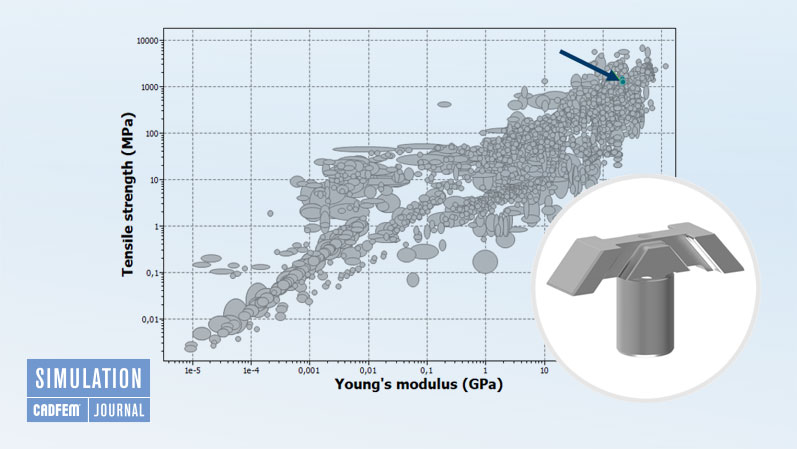Topology and parameter optimization increase process dynamics
Accelerate lightly
With the development of increasingly lighter chucks for turning, SCHUNK serves the requirements of its customers who want to produce their components quickly and energy-efficiently. For this purpose, SCHUNK uses simulation solutions from CADFEM, including software for topology and parameter optimization.
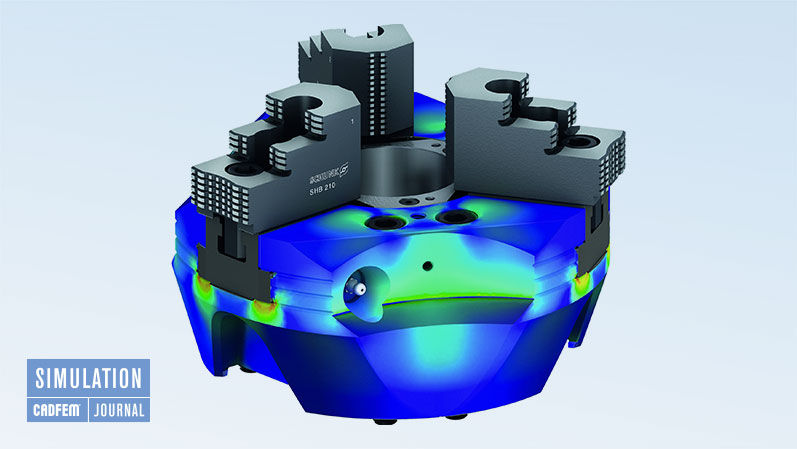
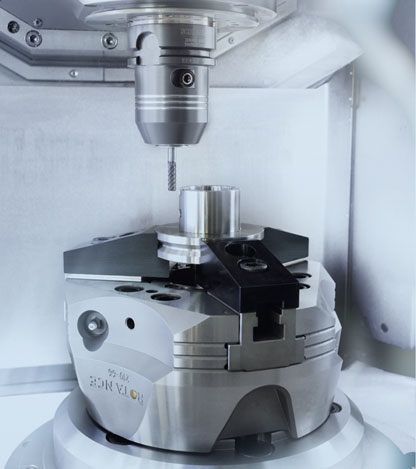
The ROTA NCE wedge-hook power chuck developed by SCHUNK combines lightweight construction, maximum load capacity and an exceptional design language all in one. The geometry of the lathe chuck was adapted to the force flow in such a way that maximum stiffness is ensured despite the lightweight construction. Compared to conventional lathe chucks, the mass inertia has been reduced by up to 40 percent, depending on the size.
In demand: High stiffness with low mass
With the development of the ROTA NCE, specialists at the SCHUNK Competence Center for Turning Technology and Stationary Toolholding Systems in Mengen, Upper Swabia, wanted to contribute to improving energy management in accordance with DIN EN ISO 50001. The aim was to develop a clamping device with a low mass or mass inertia in order to minimize the required acceleration energy and acceleration duration. However, the basic clamping function of the chuck - measured in terms of stiffness and variability - was to be fully retained, and, if possible, even increased. The desired radial and axial runout accuracy also had to be ensured.
For this purpose, a topology optimization was used to determine the coarse structure of the clamping device components on the basis of the respective force flow. In the parameter optimization based on this, the resulting dimensions were varied in such a way that an optimum fine structure was created. The properties of the clamping device designed in this way could then be evaluated by FE analyses and compared with previously manufactured clamping devices.
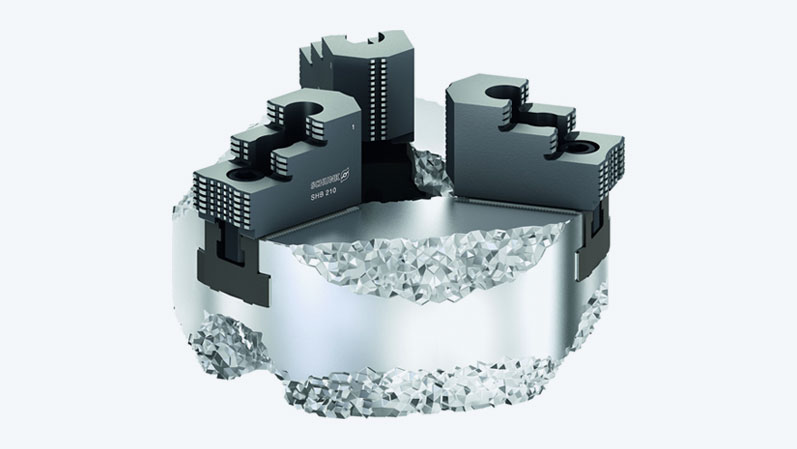
SCHUNK ROTA NCE is an extremely lightweight 3-jaw power chuck with innovative design for large savings potential with dynamic processes. The chuck is ideal for use on machines with short-stroke cylinders. More at schunk.com
Arch structures underneath the jaws
"For the topology optimization, we defined an initial model in Ansys that contains the necessary constraints such as forces and bearings," explains Mathias Siber, who made the project the subject of his master's thesis. "The objective function of the optimization was chosen to maximize stiffness, with mass restrictions of 70, 50 and 30 percent of the initial mass, respectively." In addition, the existing functional areas were marked to exclude them from the optimization (non-design areas), because they were to remain in their original form.
The optimization algorithm then determined the basic geometric shape according to the mechanical loads and depending on the specified mass restrictions. This resulted in arch structures in the chuck body below the jaw guide and circular recesses between the guideways, as well as an overall conical chuck contour.
"Topology optimization has made it possible to significantly reduce the weight of the lathe chuck, which also has a positive effect on the load on the spindle bearing," reports Philipp Schräder, Head of Development Clamping Technology. "In addition, we have registered the arch structure resulting from the topology optimization as a design patent with the German Patent and Trademark Office in order to protect ourselves as far as possible against imitations."
Sensitivity studies show influence of parameters
After the topology optimization, the parameter optimization was carried out using sensitivity studies with Ansys optiSLang. This allowed the influence of the input parameters on the targeted output data to be analyzed, visualized and evaluated. The subsequent optimization algorithm searched for the minimum of the correspondingly defined target function, including as little bulking as possible even at high clamping force.
In addition to the chuck body, the base and top jaws were also taken into account. "With optiSLang, we were able to examine what the jaw guidance must look like," explains Mathias Siber. "We analyzed which parameter changes would lead to the desired result, namely little deformation with low weight."
For the base jaw, the mass and the axial bulging were decisive. The parameters "depth of the guide in the chuck body" and "width of the guide groove" dominated. The depth of the guide had opposite effects, because the deeper the guide lies in the chuck body, the lower its upward bulging. In contrast, however, the mass of the base jaw increases proportionally.
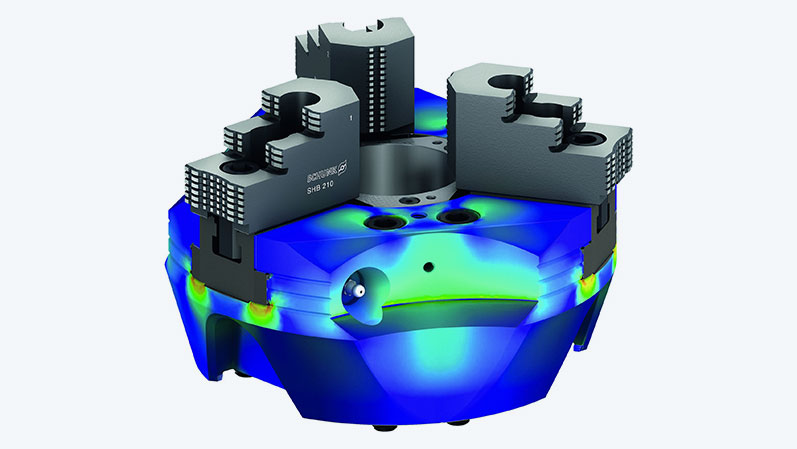
Multi-objective optimization facilitates design
In the case outlined, optimization is carried out according to the parameter constellation with low flaring and simultaneously lowest base jaw mass. The result of this multi-objective optimization is an optimum depth-to-width ratio of 2:3 for the base jaw guide. This allows the behavior of the product with different layouts to be analyzed in great detail in order to create a "robust" design.
While topology optimization was used to calculate the lightest possible chuck shape from the force flow, parameter optimization was used to ensure maximum stiffness and reduced notch stresses in order to achieve the longest possible chuck life cycle. In addition, a computational strength verification was carried out according to the FKM guideline.
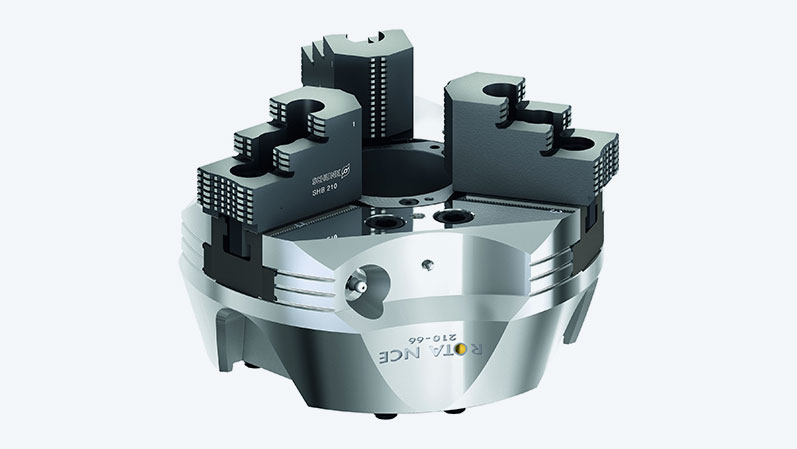
Prototype meets all requirements
After optimization, prototypes of each chuck size were manufactured. These were then examined and verified on the test rig, with up to 500,000 cycles tested, which took several months. "As with other projects, the extensive simulations during development meant that only one prototype was needed for each size, which fully met the specified requirements," emphasizes Philipp Schräder. "Since a prototype test can take several months, the time saved by the simulation is also in this size range, which means about half a year for a new development."
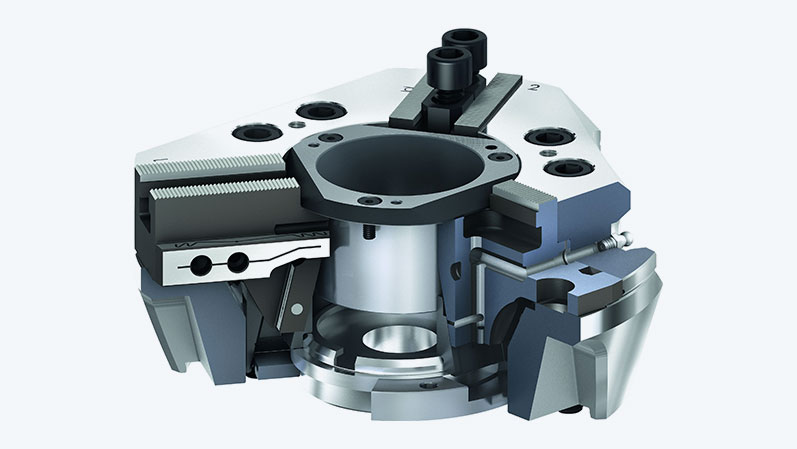
By optimizing the topology and parameters, it was possible to realize a lightweight chuck in which the mass was reduced by 30 percent and the inertia by 40 percent. This results in advantages such as shorter acceleration phases and a lower drop in clamping force under rotational speed, resulting from a 20 percent lower jaw centrifugal mass. By optimizing the parameters in the area of the jaw guidance, an increase in the stiffness of the chuck was also achieved with a simultaneous reduction in the stress level.
This results in a 20 percent increase in the maximum tolerable clamping force. In conjunction with the reduced jaw centrifugal mass, a possible speed increase of 10 percent can thus be achieved.
ISO 50001 is a globally valid standard of the International Organization for Standardization (ISO), which is intended to support organizations and companies in establishing systematic energy management; it can also be used to demonstrate an energy management system that complies with the standard through certification. (Source: Wikipedia)
Higher productivity and less energy consumption
For the user, the SCHUNK ROTA NCE lathe chuck offers ideal conditions for high process dynamics and productivity with minimal energy consumption. Particularly in large-scale production, the energy- and cycle-time efficient chuck leads to significant savings and is thus ideally suited for the energy management certification DIN EN ISO 50001.
SCHUNK and CADFEM have been working together for many years in the field of numerical simulation with Ansys. SCHUNK entered the field of numerical simulation with Ansys at an early stage, with CADFEM as a partner for all questions concerning the procurement of the software, as well as everything necessary for its efficient use such as hardware, training, user support and technical support when new areas of application are opened up.

SCHUNK GmbH & Co. KG
Philipp Schräder
www.schunk.com
Author: Gerhard Friederici
(CADFEM Germany GmbH)
Images: © CADFEM Germany GmbH, 2018/2023
Contact CADFEM




